- Overview
- Device models
- Connectivity
- Additional Services
- Internal storage
- Power supply
- Device Management platform
- Visualizers
Introduction
Overview
The Smart Spot device developed by Libelium allows Air Quality and Crowd monitoring solutions.
Smart Spots are configurable IoT devices that allow monitor different environmental factors, such as air quality (gases and suspended particles), temperature, humidity and noise, as well as integrating weather stations.
The inclusion of all these sensors and capacities in a single device provides savings in the installation, maintenance and management as well as in communications.

Device models
Smart Spot supports the next models for different main purposes:
-
Smart Spot Air Quality: For AQI index purposes including gas sensors, PM1, PM2.5, PM10 sensors and noise level sensor.
-
Smart Spot Crowd monitoring: WiFi and BLE scanning purposes.
These models can be expended with extra sensors in such as weather station or specific ambient parameter sensors among others. See the list of combinations for each model for more information.
Connectivity
This device offers different main communication options: 4G, GSM-GPRS or NB-IoT.
WiFi option is always included for coverage-limited or indoor scenarios.
LoRaWAN option can be added as secondary protocol (only available in Air Quality model).
On the other hand, the Smart Spot permits the use of communication protocols such as LwM2M, MQTT, SENTILO and Modbus TCP (industrial environments) for third party integration. Furthermore, these devices are FIWARE-Ready through MQTT protocol.
Additional Services
Although the Smart Spot device supports additional protocols used for reporting data to third-party platforms like MQTT, SENTILO or Cayenne LPP, its primary method of remote interaction is the Lightweight M2M (LwM2M) protocol. It communicates through this protocol with Libelium's cloud server, where various services for the device are hosted.
These services enable different management, maintenance, monitoring, and data improvement tasks for the device throughout its lifecycle, from initial setup and factory configuration after manufacturing to remote monitoring of its operation during real deployment.
Refer to Application Note 130: Monitoring, Maintenance, and Continuous Improvement Services for extended information about the services used by the Smart Spot.
Internal storage
The Smart Spot device has the capability to internally store measurements retrieved through their sensors or services in order to avoid losing data when problems related with device connectivity or integration with third party platforms arise.
The internal storage available in the Smart Spot is 6.5MB and the main features for internal storage are:
- Storage is done working directly with flash memory in binary format instead of files format in order to:
- Reduce size storage
- Improve the stored information management speed when deleting information already reported
- Avoid issues related with file or file system formats
- Available for MQTT and SENTILO third party integration protocols
- Available ONLY for Crowd Monitoring device models. Air Quality models do not support this feature.
Power supply
To be scalable in different types of scenarios and territories, Smart Spots allow different types of outdoor and indoor power sources. In addition, as an optional feature, a high-capacity battery is available to provide autonomy against power shutdowns (for instance in street lamps).
Device Management platform
Libelium Homard platform allows the user to access to the device configuration.


Visualizers
Libelium provides customized visualizers depending on the application deployed (Crowd monitoring, Air Quality pollution, Noise Level monitoring, etc.)
